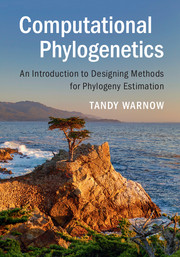Book contents
- Frontmatter
- Dedication
- Contents
- Preface
- Glossary
- Notation
- PART I BASIC TECHNIQUES
- PART II MOLECULAR PHYLOGENETICS
- Appendix A Primer on Biological Data and Evolution
- Appendix B Algorithm Design and Analysis
- Appendix C Guidelines forWriting Papers About Computational Methods
- Appendix D Projects
- References
- Index
Preface
Published online by Cambridge University Press: 26 October 2017
- Frontmatter
- Dedication
- Contents
- Preface
- Glossary
- Notation
- PART I BASIC TECHNIQUES
- PART II MOLECULAR PHYLOGENETICS
- Appendix A Primer on Biological Data and Evolution
- Appendix B Algorithm Design and Analysis
- Appendix C Guidelines forWriting Papers About Computational Methods
- Appendix D Projects
- References
- Index
Summary
Overview
The evolutionary history of a set of genes, species, or individuals provides a context in which biological questions can be addressed. For this reason, phylogeny estimation is a fundamental step in many biological studies, with many applications throughout biology, such as protein structure and function prediction, analyses of microbiomes, inference of human migrations, etc. In fact, there is a famous saying by Dobzhansky that “Nothing in biology makes sense except in the light of evolution” (Dobzhansky, 1973).
Because phylogenies represent what has happened in the past, they cannot be directly observed but rather must be estimated. Consequently, increasingly sophisticated statistical models of sequence evolution have been developed, and are now used to estimate phylogenetic trees. Indeed, over the last few decades, hundreds of software packages and novel algorithms have been developed for phylogeny estimation, and this influx of computational approaches into phylogenetic estimation has transformed systematics. The availability of sophisticated computational methods, fast computers and high-performance computing (HPC) platforms, and large sequence datasets enabled through DNA sequencing technologies, has led to the expectation that highly accurate large-scale phylogeny estimation, potentially answering open questions about how life evolved on earth, should be achievable.
Yet large-scale phylogeny estimation turns out to be much more difficult than expected, for multiple reasons. First, all the best methods are computationally intensive, and standard techniques do not scale well to large datasets; for example, maximum likelihood phylogeny estimation is NP-hard, so exact solutions cannot be found efficiently (unless P = NP), and Bayesian MCMC methods can take a long time to reach stationarity. While massive parallelism can ameliorate these challenges to some extent, it doesn't really address the basic challenge inherent in searching an exponential search space. However, another issue is that the statistical models of sequence evolution that properly address genomic data are substantially more complex than the ones that model individual loci, and methods to estimate genome-scale phylogenies are (relatively speaking) in their infancy compared to methods for single gene phylogenies.
- Type
- Chapter
- Information
- Computational PhylogeneticsAn Introduction to Designing Methods for Phylogeny Estimation, pp. xiii - xviPublisher: Cambridge University PressPrint publication year: 2017



